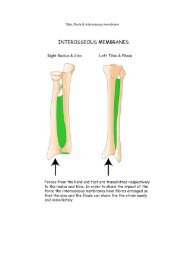GSM 11.11 version 6.2.0 - TTFN Smart card pages
GSM 11.11 version 6.2.0 - TTFN Smart card pages
GSM 11.11 version 6.2.0 - TTFN Smart card pages
- No tags were found...
Create successful ePaper yourself
Turn your PDF publications into a flip-book with our unique Google optimized e-Paper software.
(<strong>GSM</strong> <strong>11.11</strong> <strong>version</strong> <strong>6.2.0</strong> Release 1997)26TS 100 977 V<strong>6.2.0</strong> (1999-05)- operational use:'6F 2X', '6F 3X', '6F 4X' in '7F 10' and '7F 2X';'4F YX', where Y ranges from '2' to 'F' in all 2 nd level DFs.'2F 1X' in the MF '3F 00'.In all the above, X ranges, unless otherwise stated, from '0' to 'F'.7 Security featuresThe security aspects of <strong>GSM</strong> are described in the normative references <strong>GSM</strong> 02.09 [4] and <strong>GSM</strong> 03.20 [11]. This clausegives information related to security features supported by the SIM to enable the following:- authentication of the subscriber identity to the network;- data confidentiality over the radio interface;- file access conditions.7.1 Authentication and cipher key generation procedureThis subclause describes the authentication mechanism and cipher key generation which are invoked by the network. Forthe specification of the corresponding procedures across the SIM/ME interface see clause 11.The network sends a Random Number (RAND) to the MS. The ME passes the RAND to the SIM in the command RUN<strong>GSM</strong> ALGORITHM. The SIM returns the values SRES and Kc to the ME which are derived using the algorithms andprocesses given below. The ME sends SRES to the network. The network compares this value with the value of SRESwhich it calculates for itself. The comparison of these SRES values provides the authentication. The value Kc is used bythe ME in any future enciphered communications with the network until the next invocation of this mechanism.A subscriber authentication key Ki is used in this procedure. This key Ki has a length of 128 bits and is stored within theSIM for use in the algorithms described below.7.2 Algorithms and processesThe names and parameters of the algorithms supported by the SIM are defined in <strong>GSM</strong> 03.20 [11]. These are:- Algorithm A3 to authenticate the MS to the network;- Algorithm A8 to generate the encryption key.These algorithms may exist either discretely or combined (into A38) within the SIM. In either case the output on theSIM/ME interface is 12 bytes. The inputs to both A3 and A8, or A38, are Ki (128 bits) internally derived in the SIM,and RAND (128 bits) across the SIM/ME interface. The output is SRES (32 bits)/Kc (64 bits) the coding of which isdefined in the command RUN <strong>GSM</strong> ALGORITHM in clause 9.7.3 File access conditionsEvery file has its own specific access condition for each command. The relevant access condition of the last selected fileshall be fulfilled before the requested action can take place.For each file:- the access conditions for the commands READ and SEEK are identical;- the access conditions for the commands SELECT and STATUS are ALWays.No file access conditions are currently assigned by <strong>GSM</strong> to the MF and the DFs.The access condition levels are defined in the following table:ETSI








